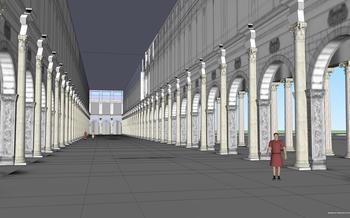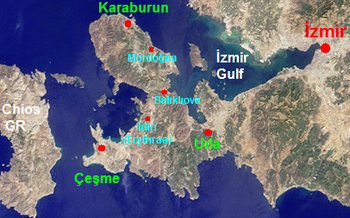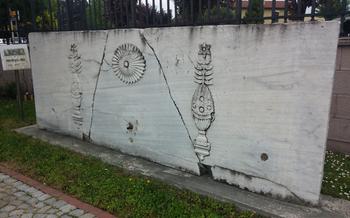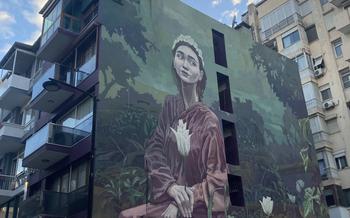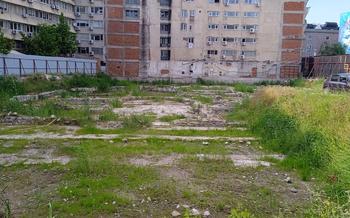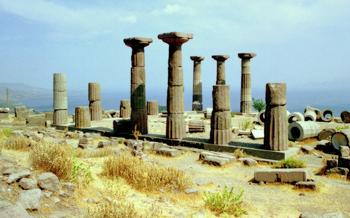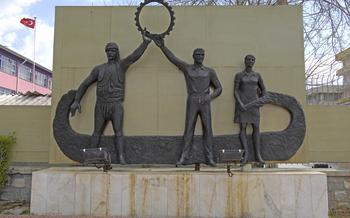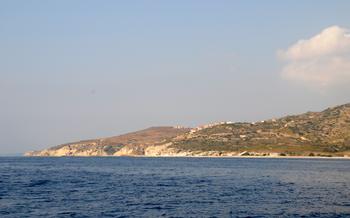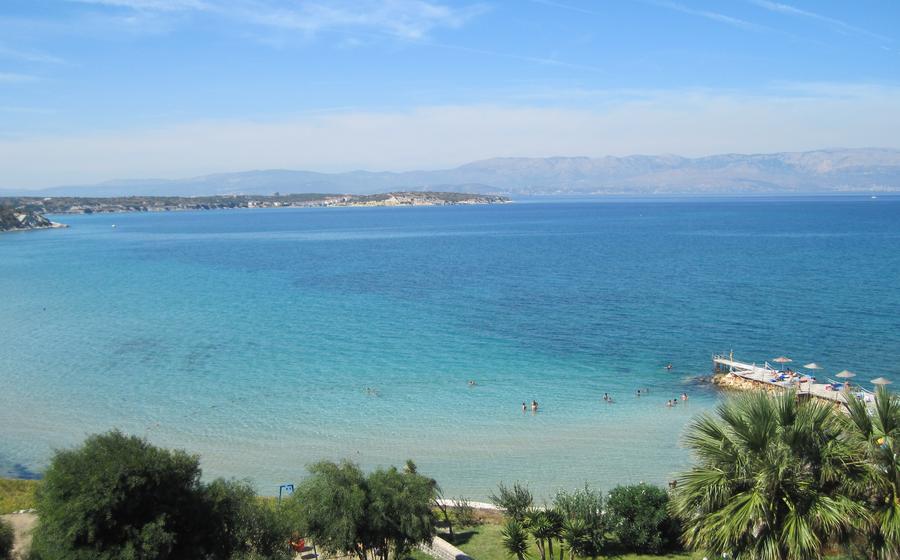
Erythrai Ancient City
- Historical Significance
- Location and Accessibility
- Entrance Fees and Visiting Hours
- Must-See Ruins and Artifacts
- Temple of Athena
- Agora and Stoa
- Acropolis and City Walls
- Theater and Odeon
- Necropolis and Tombs
- Museum of Erythrai
- CHP Çeşme Municipal Museum
- Local Cuisine and Restaurants
- Shopping in Çeşme
- Beaches Near Erythrai
- Insider Tip: Hidden Gem
Historical Significance
The ancient city of Erythrai, nestled on the western coast of Turkey, holds a significant place in the tapestry of Anatolian history. Founded by Ionian Greeks in the 11th century BC, Erythrai flourished as a prominent city-state during the Classical period. It played a crucial role in the Ionian League, a confederation of twelve Ionian cities that shared cultural, religious, and political ties. Erythrai's strategic location on the Aegean Sea made it a thriving center of trade and commerce, leaving behind a rich legacy of archaeological discoveries that provide valuable insights into its glorious past.
Location and Accessibility
Erythrai is situated on the western coast of Turkey, approximately 10 kilometers south of Çeşme and 80 kilometers west of İzmir. To reach Erythrai from Çeşme, take the coastal road towards Alaçatı and follow the signs for Erythrai. The journey takes about 15-20 minutes by car.
From İzmir, take the E87 highway towards Çeşme and exit at the junction for Alaçatı. From there, follow the signs for Erythrai. The drive from İzmir takes approximately 1 hour and 15 minutes.
Once you arrive in Erythrai, parking is available near the entrance of the ancient city. Public transportation options are limited, so renting a car or taking a taxi is recommended for those without their own vehicle.
Entrance Fees and Visiting Hours
Visiting Erythrai:
Entrance to the Erythrai Ancient City requires a modest entrance fee, which helps with the upkeep and preservation of the site. The fee is typically a few Turkish Lira or the equivalent in foreign currency. It's advisable to carry cash as card payments may not be accepted.
Operating Hours:
Erythrai is open to visitors throughout the week, with varying hours depending on the season. During the summer months (April to October), the site is typically open from 8:00 AM to 7:00 PM. In the winter (November to March), the hours may be shorter, usually from 8:00 AM to 5:00 PM.
Special Arrangements:
Guided tours of Erythrai are available upon request and with additional charges. These tours provide a more in-depth exploration of the site's history and significance, led by knowledgeable guides. Advance booking for guided tours is recommended, especially during peak tourist season.
Discounts:
Students and senior citizens are eligible for discounted entrance fees upon presenting valid identification. It's worth carrying your student ID or passport if applicable to take advantage of these discounts.
Must-See Ruins and Artifacts
As you explore Erythrai, keep an eye out for these remarkable ruins and artifacts that offer glimpses into the ancient Ionian civilization:
-
Temple of Apollo: This well-preserved temple once housed a colossal statue of Apollo, the patron god of Erythrai. Admire its impressive columns, intricate carvings, and awe-inspiring atmosphere.
-
Odeon: Step into this smaller theater, designed for musical performances and recitals. Its intimate setting and remarkable acoustics transport you back in time to ancient cultural events.
-
Bouleuterion: In the heart of the agora, discover the bouleuterion, the council chamber where Erythrai's leaders met to discuss civic matters. Its well-preserved seating rows and inscriptions provide insights into the city's governance.
-
Necropolis: Outside the city walls, explore the vast necropolis, home to a variety of tombs and sarcophagi. Admire the intricate carvings, inscriptions, and artwork that adorn these final resting places.
-
Mosaics: Throughout Erythrai, uncover stunning mosaics depicting mythological scenes, geometric patterns, and everyday life. These colorful artworks offer glimpses into the artistic and cultural expressions of the ancient Ionians.
Temple of Athena
The Temple of Athena stands as a remarkable testament to Erythrai's religious and cultural significance. Built in the 5th century BC, this Doric-style temple was dedicated to the goddess Athena, the patron deity of the city. Once a majestic structure, its ruins still convey a sense of awe and grandeur.
The well-preserved foundations outline the temple's original dimensions, allowing visitors to envision its former glory. Scattered around the site are fragments of columns, capitals, and pediments, each piece a silent witness to the temple's architectural prowess.
While much of the temple's ornamentation has been lost to time, some elements remain intact, offering glimpses into its intricate artistry. Exquisitely carved friezes depict scenes from Greek mythology, while inscriptions reveal the names of benefactors who contributed to the temple's construction.
Despite its partial state of ruin, the Temple of Athena remains a captivating sight. Its enduring presence evokes a sense of reverence and admiration, inviting visitors to contemplate the rich history and profound spirituality that once permeated this ancient Ionian city.
Agora and Stoa
The agora served as the bustling heart of Erythrai, a vibrant marketplace and meeting ground for the city's inhabitants. As you explore the excavated remains, you'll encounter remnants of shops and workshops that once lined the square, offering a glimpse into the commercial activities of ancient times.
Among the ruins, the stoa, a long, colonnaded portico, stands out as a testament to Greek architectural ingenuity. Stoas were common features in ancient cities, providing sheltered walkways and offering space for public gatherings, philosophical discussions, and commercial transactions. In Erythrai, the stoa likely served as a hub for merchants, philosophers, and citizens alike, fostering a sense of community and intellectual exchange.
As you stroll through the agora, imagine the lively atmosphere that once filled the air—the clamor of merchants hawking their wares, the laughter and chatter of friends catching up, and the earnest debates of philosophers sharing their ideas. The agora was more than just a marketplace; it was a place where the social, economic, and intellectual life of Erythrai converged, leaving a lasting legacy in the city's rich history.
Acropolis and City Walls
Standing atop a strategic hill overlooking the ancient city, the acropolis of Erythrai once served as the heart of political and religious power. Its imposing fortifications and city walls, constructed with massive blocks of stone, bear witness to the city's resilience and defensive prowess. While time has weathered these structures, their grandeur remains evident, inviting visitors to explore their intriguing history.
Ascend the winding path leading to the acropolis, and you'll be rewarded with awe-inspiring panoramic vistas that stretch across the entire city, the shimmering Aegean Sea, and the surrounding countryside. Imagine the bustling activities that took place within these walls, as ancient Greek citizens gathered for religious ceremonies, political debates, and strategic planning.
Although the passage of time has left its mark on the acropolis, remnants of its former glory persist. Scattered fragments of temples, altars, and administrative buildings hint at the vibrant life that once unfolded here. Explore the foundations of these structures, piece together their past, and let your imagination transport you back to the days when Erythrai stood as a beacon of Ionian civilization.
Theater and Odeon
The ancient theater of Erythrai is a testament to the city's cultural significance. Built in the 3rd century BC, it could accommodate up to 5,000 spectators and hosted theatrical performances, musical concerts, and public gatherings. The well-preserved remains of the theater include the stage, orchestra, and seating tiers, providing a glimpse into the entertainment and civic life of ancient Erythrai.
Adjacent to the theater is the odeon, a smaller venue with a capacity of around 1,500 people. Constructed in the 2nd century AD, the odeon was used for more intimate performances, such as recitals, poetry readings, and chamber music concerts. Its acoustics are remarkably well-preserved, allowing visitors to imagine the vibrant sounds that once filled the space.
Both the theater and the odeon offer stunning views of the surrounding countryside, with the Aegean Sea sparkling in the distance. Visitors can wander through the ancient seating areas, marveling at the intricate carvings and inscriptions that adorn the stonework. The theater and odeon are must-see attractions for anyone interested in the performing arts and the rich cultural heritage of Erythrai.
Necropolis and Tombs
Location and Types of Tombs in Erythrai The necropolis, or cemetery, of Erythrai is located outside the city walls and contains a variety of tombs dating from different periods. The most common type of tomb is the rock-cut chamber tomb, which was carved into the soft rock of the hillside. These tombs typically have a rectangular or square chamber with a vaulted ceiling and a dromos, or entrance passage. Some chamber tombs are decorated with paintings, sculptures, and inscriptions.
Significance of Funerary Art and Inscriptions The funerary art and inscriptions found in the tombs of Erythrai provide valuable insights into the beliefs and practices of the ancient Greeks. The paintings often depict scenes from Greek mythology or everyday life, while the sculptures and inscriptions record the names and achievements of the deceased. These artifacts help us to understand the social and cultural values of the people who lived in Erythrai.
Examples of Well-Preserved Tombs One of the most well-preserved tombs in the necropolis of Erythrai is the Tomb of the Nereids. This tomb dates from the 4th century BC and is decorated with a series of exquisite sculptures depicting the Nereids, sea nymphs, and other mythological figures. Another well-preserved tomb is the Tomb of the Warrior, which dates from the 5th century BC and contains a sculpture of a warrior wearing a helmet and armor.
Museum of Erythrai
The Museum of Erythrai, located in the heart of the ancient city, serves as a treasure trove of artifacts and insights into the rich history of Erythrai. Established in the 1960s, the museum houses a diverse collection of relics unearthed during archaeological excavations at the site.
As you step inside, you'll be greeted by an array of exhibits that showcase the artistry and craftsmanship of the ancient Erythraians. Intricate pottery, bronze sculptures, and finely carved marble inscriptions adorn the museum's displays, offering glimpses into the daily lives, religious beliefs, and cultural practices of this once-thriving city.
Among the highlights of the museum's collection are a series of stunning mosaics that depict scenes from Greek mythology and everyday life. These intricate artworks, painstakingly crafted by skilled artisans, provide a vibrant glimpse into the artistic traditions of ancient Erythrai.
The museum also features interactive displays and educational resources that bring the history of the city to life. Through multimedia presentations and hands-on exhibits, visitors can explore the urban planning, architecture, and economy of ancient Erythrai, gaining a deeper understanding of its significance as a major center of trade and culture in the ancient world.
CHP Çeşme Municipal Museum
Located in the heart of Çeşme, the CHP Çeşme Municipal Museum offers a glimpse into the rich history and culture of the region. Established in 1999, the museum houses a diverse collection of artifacts, documents, and exhibits that shed light on Çeşme's past, particularly during the Ottoman period.
The museum's exhibits are arranged in chronological order, taking visitors on a journey through Çeşme's transformation from a small fishing village to a bustling port town. Highlights include traditional costumes, tools, and household items that provide insights into the daily lives of Çeşme's residents.
The museum also features a section dedicated to the history of the Çeşme Castle, a prominent landmark that played a crucial role in defending the town against naval attacks. Visitors can learn about the castle's construction, its strategic importance, and the battles that took place within its walls.
The CHP Çeşme Municipal Museum is a valuable resource for anyone interested in exploring the history and heritage of Çeşme. Its exhibits offer a fascinating glimpse into the town's past and provide a deeper understanding of its cultural identity.
Local Cuisine and Restaurants
Çeşme, renowned for its culinary delights, offers a tantalizing array of flavors to satisfy every palate. Don't miss the chance to savor the region's signature dishes, such as the succulent grilled octopus, a local delicacy expertly prepared with fresh herbs and olive oil. For a taste of traditional Turkish cuisine, indulge in "Çeşme kumrusu," a mouthwatering toasted sandwich filled with sausage, cheese, tomato, and herbs.Seafood lovers will be in heaven with the abundant fresh catches of the day, grilled to perfection and served with tangy sauces. Complement your meal with a glass of local wine or "raki," a traditional anise-flavored spirit, to fully immerse yourself in the local culinary experience.
To enhance your gastronomic journey, venture beyond the main tourist areas and seek out hidden gems where locals dine. Ask for recommendations from your hotel concierge or friendly locals to discover authentic restaurants serving up traditional recipes passed down through generations. Be prepared to embrace the vibrant atmosphere of bustling markets, where you can haggle for fresh produce, spices, and local delicacies. With its rich culinary heritage and passionate food culture, Çeşme promises an unforgettable culinary adventure for every traveler.
Shopping in Çeşme
When exploring Erythrai, take some time to delve into the vibrant shopping scene of Çeşme. The town boasts a variety of local markets and bazaars, where you can find an array of souvenirs and unique treasures. From intricately designed handicrafts and ceramics to traditional textiles and garments, these markets offer a glimpse into the rich cultural heritage of the region.
One of the must-visit markets is the Çeşme Bazaar, located in the heart of the town. Here, you can haggle for colorful carpets, handwoven bags, and exquisite jewelry. The bazaar is a feast for the senses, with vendors calling out their wares and the air filled with the scent of spices and freshly baked goods.
For those seeking unique ceramics, the Ilica Pottery Market is a must-visit. This market showcases the talents of local artisans who create beautiful handmade pottery, ranging from decorative plates and vases to intricate figurines. You can watch the potters at work and even try your hand at creating your own piece of art.
When shopping in Çeşme, don't be afraid to bargain. It's a local custom, and you can often get a good deal if you're willing to haggle. Be respectful and friendly, and enjoy the experience of interacting with the local vendors.
Remember to bring cash as some vendors may not accept credit cards. Also, be mindful of market etiquette. Respect the vendors and their goods, and avoid touching or handling items unless you're serious about buying them.
Shopping in Çeşme is a delightful experience that allows you to take home a piece of the town's rich culture and heritage. So, be sure to set aside some time to explore the local markets and bazaars during your visit to Erythrai.
Beaches Near Erythrai
After exploring the ancient ruins, take a break and enjoy the sun-kissed beaches near Erythrai. A short drive from the site will lead you to a range of beautiful beaches with crystal-clear waters and golden sands. Whether you're seeking a secluded spot for relaxation or a place to indulge in water sports, you'll find plenty of options to choose from. Facilities like sunbeds, umbrellas, and cafes are available at most beaches, ensuring a comfortable and enjoyable experience. For those who love to dive or snorkel, the clear waters offer excellent visibility and a chance to explore the vibrant marine life. Remember to bring your swimsuit, sunscreen, and a camera to capture the stunning coastal scenery.
Insider Tip: Hidden Gem
Beyond the main attractions of Erythrai, there's a hidden gem waiting to be discovered. Tucked away on the outskirts of the ancient city, you'll find the mesmerizing Kızıl Avlu (Red Courtyard). This unique spot is a picturesque haven adorned with vibrant red flowers, creating a striking contrast against the backdrop of ancient ruins. As you wander through the courtyard, you'll encounter enchanting corners perfect for capturing Instagram-worthy shots. Whether you're a photography enthusiast or simply seeking a tranquil escape, Kızıl Avlu offers a serene oasis to unwind and immerse yourself in the beauty of Erythrai's hidden treasures.
